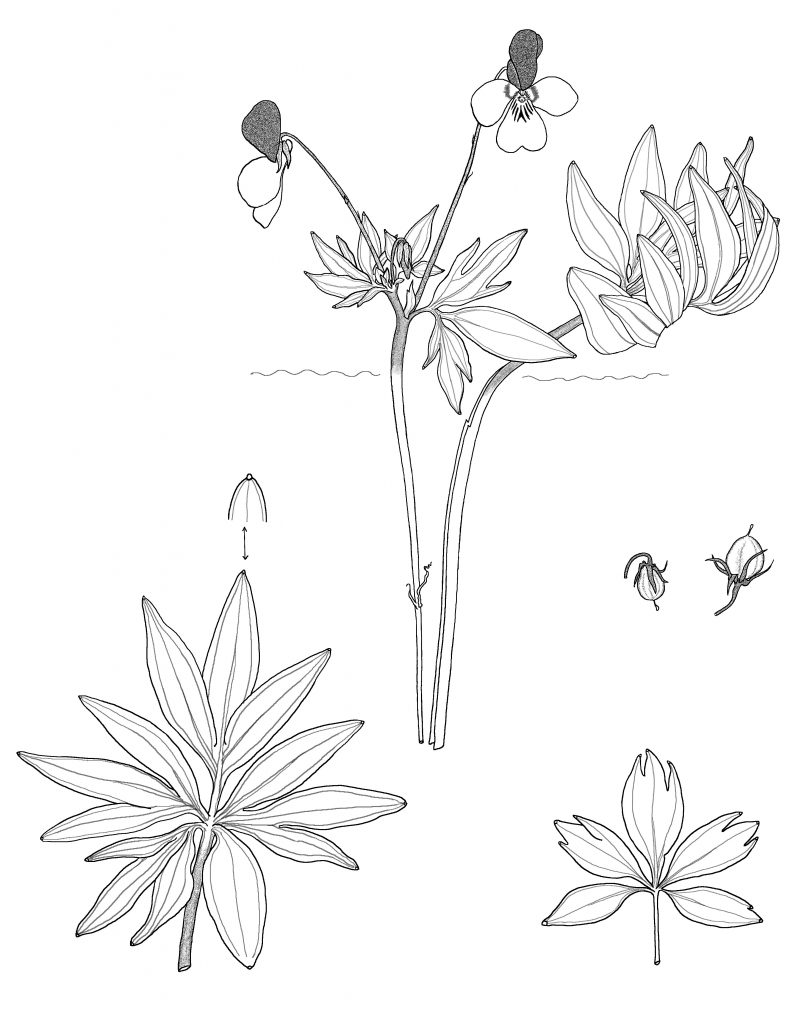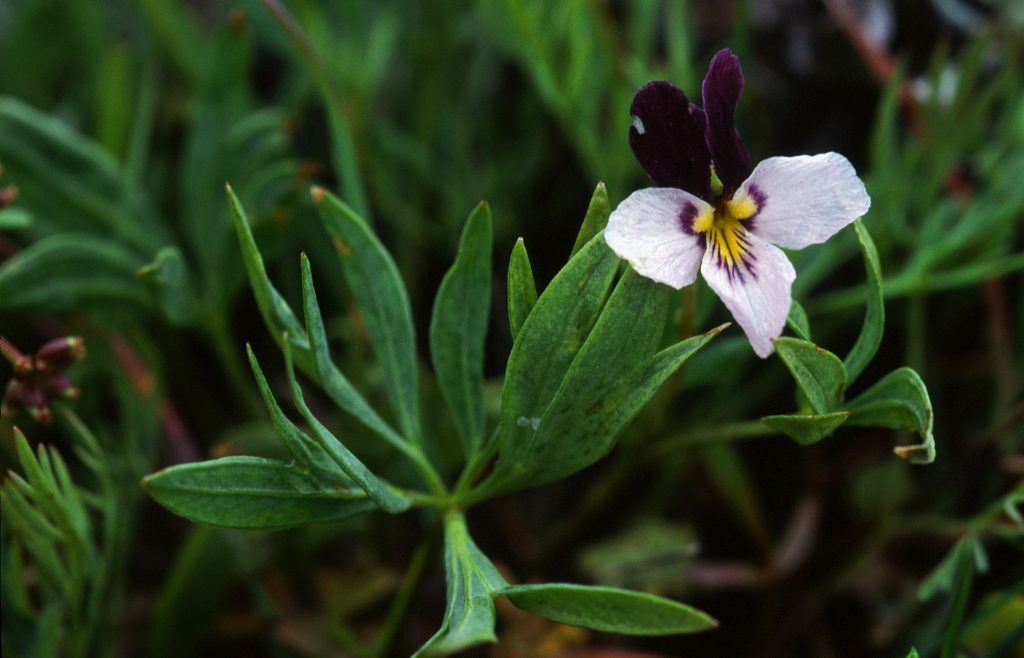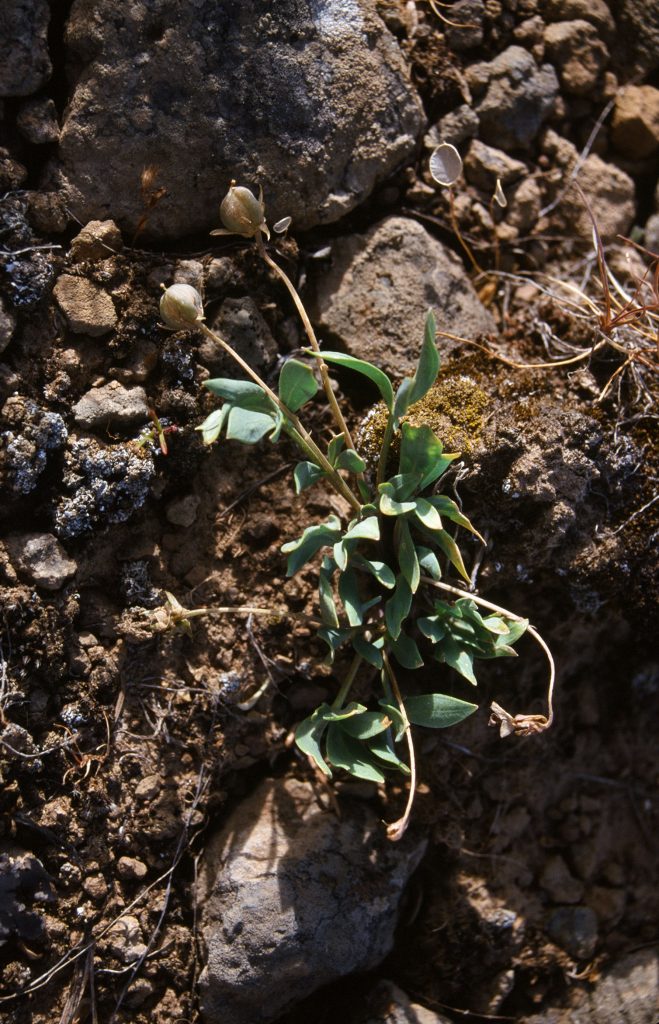Viola trinervata
Description. Illustrations: 3 photographs of Viola trinervata and 2 drawings.
This violet species is named for the three prominent veins easily visible on the erect glaucous leaves. It is found in the lithosol soils of central Washington State and northern Oregon with a disjunct population in south eastern Oregon in the Great Basin. It is so similar to Viola beckwithii that a full description will be mostly repetitive. Basal leaves are deeply pedately divided, and each primary division divided again, deeply or shallowly. Stem leaves are usually palmately divided only once. Although it was originally considered to be a variety of Viola beckwithii, their ranges do not overlap. The differences between these two species are that V. trinervata is glabrous throughout, the leaves are more leathery, the leaf lobes are fewer, longer and wider, and the soils on which they grow are more shallow. Flower color, shape and size are the same as those of Viola beckwithii, either a combination of dark violet upper petals and paler lilac lower three petals, or an even more beautiful form of dark purple-violet with pure white lower petals; all with a characteristic yellow central eye.

Like V. beckwithii and V. douglasii the adnate stipules and wide-based petioles form an underground protective fibrous sheath around the stems and petioles, the crown of the plant being buried well below the surface of the soil, either on or near the underlying dark basalt rock. As with related species from dry locations, in the first year the cotyledons appear, basal leaves in the second spring, then stems with flowers in subsequent years. Because their growing season is so short, only chasmogamous flowers are produced, and the copious seed dispersed within a month. By summer the plants have dried up and appear dead but are only dormant till the following spring. The scant moisture they receive is in autumn to early spring, mainly as snow and fog, the average precipitation being 25 to 38 cm. It is an upland plant that has adapted to the extremes of climate in its environment.

Mature plants produce 2-3 basal leaves and several stems up to 15 cm tall; the above ground portion is purple. The rhizome is very short with stout, long, fibrous, roots widely spreading into rock cracks to absorb moisture. Cauline leaves are concentrated at the top of the stems; the stipules of the cauline/stem leaves are green, tapering and not adnate. Basal petioles are longer than those on the stems, bringing all leaf blades to about the same height, just above the ground level. The basal leaf blade is up to 8 cm long and about as wide, orbicular in outline, the lobes lanceolate or elliptic, 1.5-4 cm long, acute, with an obvious pale gland at the tip of each segment. Leaves stand erect and at maturity become firm and thick, the leaf segments overlapping at their base. The three parallel veins are more obvious on the lower leaf surface. The calyx is green plus purple, 5-9 mm long, sepals narrow-lanceolate; appendages very short, less than 0.5 mm.

Large fragrant flowers appear above the leaves in early spring, on purple peduncles, from the axils of the stem leaves. Purple bracteoles above the middle of the peduncle are 0.2 cm long. The flower buds are dark purple. Flowers are 1.5-2-2.2 cm wide x 2.3 cm long. The two upper velvet-like, dark-violet petals often overlap or fold back to back, as also seen with V. beckwithii and V. pedata; the lower three varying from pale to deep lilac, depending on the soil, or more unusually pure white. On the two lateral petals yellow clavate hairs occur on the central yellow eye, surrounded by a dark purple. The larger lowest petal is emarginate at the end and marked with short, dark-purple guidelines. The ovary is green, glabrous. Short hairs projecting from both sides and back of the style head; large stigmatic opening with a short lower lip. The green-yellow spur is 0.6-1.5 mm long, 2 mm wide and rounded.
Viola trinervata seeds
Pale creamy-brown seeds are produced from green-purple pods, 0.9-1.0 cm long. There are no cleistogamous seed pods. Seeds are 4.0-4.5 x 1.5-2.0 mm.
Viola trinervata occurs in very dry, high desert country on open valley floors and rocky hillsides. The thin layer of poorly developed soil, called lithosol or rock-soil, lies over the basalt bed-rock. This is broken by occasional fissures, the result of constant winter freezing and thawing. During winter, water cannot penetrate the bedrock so the soils become saturated. The plants face south to southwest in the very hottest sunny places well separated from other plants competing for sparse moisture. Because of the difficult environmental conditions, rather than in spite of them, the lithosols provide some of the most spectacular arrays of alpine spring flowers to be found in the sagebrush steppe.
This violet is commonly found in the Columbia Basin of Central Washington state, from above the belt of oaks and pines in the eastern foothills of the Cascade Range, east and south into Northern Oregon across the Columbia River, and a disjunct population in Sherman and northern Malheur Counties of southeastern Oregon at its southern limit in the Great Basin. The Columbia Plateau consists entirely of black basalt lava flows, almost all erupted from the SE corner of Washington state and nearby Oregon 10-15 million years ago. West of this is newer basalt from the western cascade volcanic eruptions with later glacial gravel sediments deposited on top. These low rainfall desert areas have a pH varying from 6.2-7.0 while those of the Great Basin are reported to be more alkaline, pH 7.8 to 8.3. The Great Basin area has permanent and intermittent lakes with no outlets, so minerals rise to the surface resulting in alkaline conditions.

Nomenclature and Taxonomy
Section Chamaemelanium Ging., subsection Chrysanthae Clausen, 1964.
Viola trinervata (Howell) Howell ex A.Gray — Bot. Gaz. 11: 290. 1886
(syn. Viola beckwithii var. trinervata Howell, Bot. Gaz. 8:207. 1883 collected by Thomas Howell, Goldendale, Washington state, April 1, 1878; Viola chrysantha var. glaberrima Torr. Bot. Wilkes Exp. 238. 1874).
A tetraploid species, 2n=4x=24 where x=6, the base chromosome number of this section.
